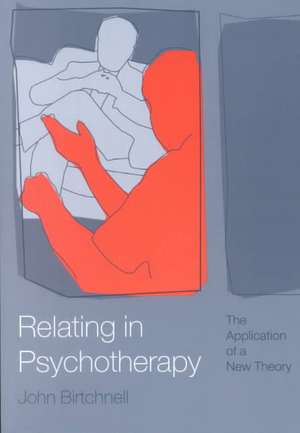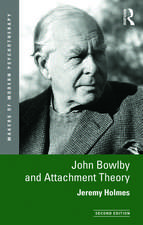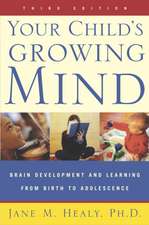Relating in Psychotherapy: The Application of a New Theory
Autor John Birtchnellen Limba Engleză Paperback – 2 mai 2002
The theory is constructed around two major axes; a horizontal one concerning the degree to which we need to become involved with or separated from others, and a vertical one concerning the degree to which we choose to exercise power over others or permit others to exercise their power over us. With numerous clinical examples, John Birtchnell explains how we need to be competet in all four relating positions (close, distant, upper and lower), and argues that people who seek therapy usually lack competence in one or more of them, but through the course of therapy, their relating capabilities can be improved.
Relating in Psychotherapy can have applications in psychotherapy and in couple and family therapy, and will be an invaluable resource for therapists, counsellors and other mental health professionals.
| Toate formatele și edițiile | Preț | Express |
|---|---|---|
| Paperback (1) | 248.47 lei 6-8 săpt. | |
| Taylor & Francis – 2 mai 2002 | 248.47 lei 6-8 săpt. | |
| Hardback (2) | 302.95 lei 6-8 săpt. | |
| Taylor & Francis – 13 noi 2017 | 302.95 lei 6-8 săpt. | |
| Bloomsbury Publishing – 27 feb 1999 | 469.07 lei 6-8 săpt. |
Preț: 248.47 lei
Preț vechi: 312.22 lei
-20% Nou
Puncte Express: 373
Preț estimativ în valută:
47.54€ • 49.64$ • 39.35£
47.54€ • 49.64$ • 39.35£
Carte tipărită la comandă
Livrare economică 05-19 aprilie
Preluare comenzi: 021 569.72.76
Specificații
ISBN-13: 9781583912751
ISBN-10: 1583912754
Pagini: 288
Dimensiuni: 156 x 234 x 21 mm
Greutate: 0.53 kg
Ediția:Revised
Editura: Taylor & Francis
Colecția Routledge
Locul publicării:Oxford, United Kingdom
ISBN-10: 1583912754
Pagini: 288
Dimensiuni: 156 x 234 x 21 mm
Greutate: 0.53 kg
Ediția:Revised
Editura: Taylor & Francis
Colecția Routledge
Locul publicării:Oxford, United Kingdom
Public țintă
Postgraduate and ProfessionalCuprins
Relating and its Relevance for Psychotherapy. The Inner Brain and The Outer Brain. The Proximity Axis in Relating. The Proximity Axis in Psychotherapy. The Power Axis in Relating. The Power Axis in Psychotherapy. Interrelating. Interrelating in Psychotherapy. Measuring Relating and Interrelating in Psychotherapy. The Emergence of a New Approach to Psychotherapy.
Recenzii
'Birtchnell has developed instruments for measuring incompetence in relating [ ] and gives instances of both research and clinical use of these in a lucid manner that draws the reader like a magnet.' - Counselling and Psychotherapy Journal
'I commend this book to you. The theory cuts across all forms (schools) of therapy, and is a way of describing each school in terms of relating, in both the client and the therapist ... I hope it will be widely read.' - Dale Mathers, Member of the International Association of Analytical Psychology
'For individual, group, couple and family therapists, Relating in Psychotherapy does an excellent job of providing a theory that helps in thinking about two important aspects of human relating (proximity and power), measuring difficulty in these areas, and providing a psychotherapeutic approach that is valid in many formats and the effect of which is measurable.' - Jill Savege Scharff, International Institute of Object Relations Therapy, Washington
'This book is easy to read, well structured, and demonstrates the author's wide knowledge of different psychotherapies The author should be congratulated for his painstaking work in developing a theory, putting it into practice, and producing meaningful measurement. This is a formidable attempt to produce an evidence-based psychotherapy.' - Anthony W. Bateman, Secretary of the Psychotherapy Faculty of the Royal College of Psychiatrists
'Birtchnell has developed instruments for measuring incompetence in relating [ ] and gives instances of both research and clinical use of these in a lucid manner that draws the reader like a magnet.' - Counselling and Psychotherapy Journal
'I commend this book to you. The theory cuts across all forms (schools) of therapy, and is a way of describing each school in terms of relating, in both the client and the therapist ... I hope it will be widely read.' - Dale Mathers, Member of the International Association of Analytical Psychology
'For individual, group, couple and family therapists, Relating in Psychotherapy does an excellent job of providing a theory that helps in thinking about two important aspects of human relating (proximity and power), measuring difficulty in these areas, and providing a psychotherapeutic approach that is valid in many formats and the effect of which is measurable.' - Jill Savege Scharff, International Institute of Object Relations Therapy, Washington
'This book is easy to read, well structured, and demonstrates the author's wide knowledge of different psychotherapies The author should be congratulated for his painstaking work in developing a theory, putting it into practice, and producing meaningful measurement. This is a formidable attempt to produce an evidence-based psychotherapy.' - Anthony W. Bateman, Secretary of the Psychotherapy Faculty of the Royal College of Psychiatrists
'Birtchnell has developed instruments for measuring incompetence in relating [ ] and gives instances of both research and clinical use of these in a lucid manner that draws the reader like a magnet.' - Counselling and Psychotherapy Journal
Notă biografică
John Birtchnell is Honorary Senior Lecturer at the Institute of Psychiatry and Honorary Psychiatrist at the Maudsley Hospital, London. He is the author of How Humans Relate: A New Interpersonal Theory, (Psychology Press, 1996).
Descriere
Explains how the relevance of Birtchnell's theory as a basis for the science of relating relates to the practice of psychotherapy.


















